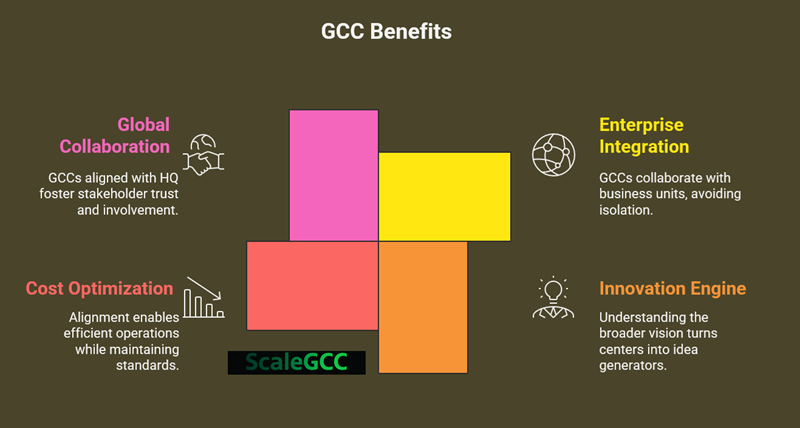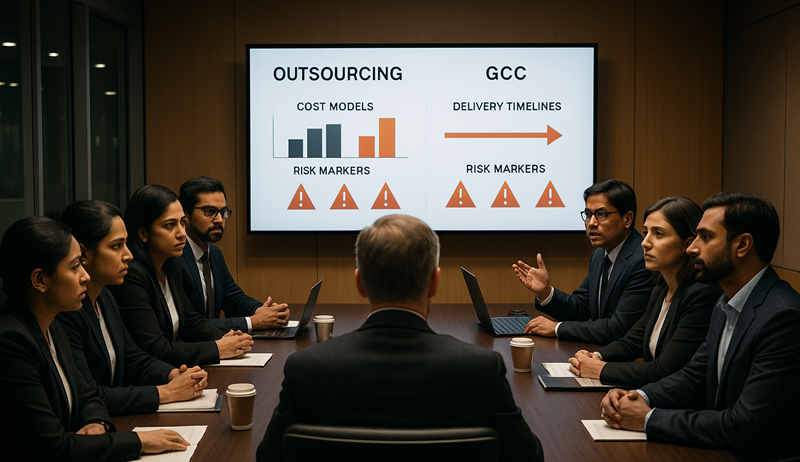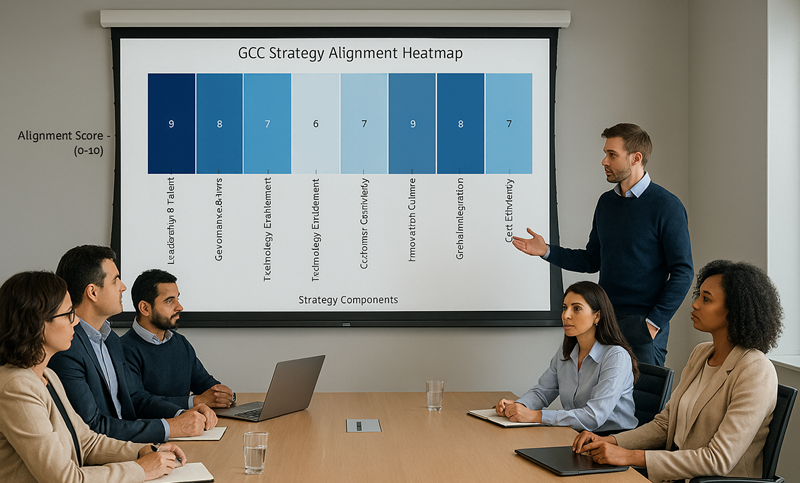Now Reading: How a Well-Aligned GCC Strategy Creates Global Impact
-
01
How a Well-Aligned GCC Strategy Creates Global Impact
How a Well-Aligned GCC Strategy Creates Global Impact
ScaleGCC Editorial TeamSetup2 months ago612 Views

In today’s volatile global economy, a well-aligned Global Capability Center (GCC) strategy isn’t just a support function; it’s a competitive differentiator. As companies scale operations, tap into diverse talent pools, and accelerate digital transformation, aligning GCCs with corporate vision and operational goals has become mission-critical.
In this blog, we’ll explore how a strategically aligned GCC drives real business impact across regions, functions, and industries.
What Is a Global Capability Center Strategy?
A Global Capability Center strategy refers to how multinational organizations design, operate, and evolve their captive centers across locations like India, Poland, Mexico, or the Philippines. These centers deliver core functions such as technology, analytics, finance, HR, and supply chain not just cost arbitrage, but value creation hubs.
The GCC strategy covers decisions on:
Location selection based on talent and cost
Operating model and governance
Digital enablement and automation
Talent development and career pathing
Innovation and IP contribution
Why Strategic Alignment Matters for GCCs in 2025

As we move deeper into 2025, strategic alignment has become the difference between a GCC that functions and one that makes a lasting impact. The outdated notion of capability centers as mere cost-saving outposts has faded. Today, leading organizations expect their GCCs to drive innovation, scale operations, and create real business value.
Here’s why getting the alignment right is more important than ever:
Enterprise Integration: Moving in Lockstep with the Business – An aligned GCC doesn’t sit on the sidelines; it grows with the business. These centers are designed to reflect the company’s goals, workflows, and performance metrics. That means what’s being delivered on the ground is directly in tune with what the business needs globally. The result? Smoother handoffs, faster decisions, and real-time collaboration across teams and time zones.
Innovation from the Inside – When a GCC has a clear view of the organization’s broader mission, it becomes a breeding ground for ideas. Instead of waiting for instructions, these centers take initiative, whether that’s building new AI tools, improving digital experiences, or rethinking supply chain flows. Alignment empowers teams to act like partners, not processors, and that changes everything.
Smarter Cost Control and Lower Risk – Yes, alignment helps reduce costs, but more importantly, it reduces waste. Teams concentrate on priorities that matter, avoid duplicated efforts, and integrate automation intelligently. And because they’re plugged into enterprise strategy, these GCCs also stay on top of compliance, security, and governance by design, not as an afterthought.
Trust That Crosses Borders – When headquarters and the GCC are aligned, communication is easier, expectations are clearer, and relationships are stronger. Stakeholders don’t just see the center as a delivery arm, they recognize it as a trusted contributor. That opens the door for more responsibility, more visibility, and greater long-term influence.
From Delivery Hub to Strategic Growth Engine – The real magic happens when a GCC shifts from being a “task team” to a true value creator. Suddenly, product rollouts speed up. Service quality improves. Innovation flows from every level. Instead of reacting to business needs, aligned GCCs help shape them, playing an active role in global growth and transformation.
Key Components of a Well-Aligned GCC Operating Model
Key Components of a Well-Aligned GCC Operating Model. To align a GCC with enterprise priorities, leaders must build a robust GCC operating model that includes:
1. Leadership and Talent Strategy – Hire local leaders who understand both global business and regional context. Upskill teams continuously to build cross-functional capabilities.
2. Outcome-Driven Governance – Shift from activity tracking to outcome-based KPIs like revenue enablement, cycle time reduction, and innovation output.
3. Technology Enablement – Invest in platforms, automation, and AI that integrate seamlessly across global systems.
4. Customer-Centric Mindset – Whether serving internal teams or end customers, GCCs must embrace empathy, feedback, and responsiveness.
5. Culture and Change Management – Align culture, not just processes. Build ownership, pride, and collaboration across borders.
Common Pitfalls and How to Avoid Them
Misaligned Metrics: One of the biggest traps a GCC can fall into is sticking too closely to traditional cost-efficiency metrics like hourly rates, headcount, or budget savings while the business has moved on to prioritize agility, speed, and innovation. If your center is still reporting “hours saved” when the C-suite is looking for “time to market,” you’re speaking the wrong language. Strategic alignment means evolving your metrics to reflect what the business truly values today.
Lack of Stakeholder Engagement: Even the most capable GCC can lose direction if it’s not actively connected to the mothership. Without consistent touchpoints with HQ and business leaders, priorities drift, assumptions go unchecked, and valuable context gets lost. Regular engagement ensures that the GCC isn’t just guessing what’s important; it knows, adapts, and delivers on it.
Underutilized Talent: Many GCCs are filled with smart, creative people but if their roles are limited to rote execution, that talent goes to waste. When leadership doesn’t empower local teams to think critically, solve problems, or propose improvements, they miss out on breakthrough ideas that could move the business forward. Leveraging on-ground expertise is not a bonus, it’s a strategic necessity.
Over-standardization: While global standards are important for scale, applying the same blueprint to every location without flexibility can backfire. Over-standardization often means ignoring cultural dynamics, local market needs, or even regulatory differences. The result? Lower engagement, ineffective processes, and resistance from teams who feel boxed in. A truly effective GCC strategy balances consistency with adaptability.

Conclusion: Scaling With Purpose Through GCC Strategy
In 2025 and beyond, your GCC strategy isn’t just about where you operate; it’s about how aligned you are with your business goals. A well-aligned GCC drives innovation, attracts global talent, enhances resilience, and delivers outcomes at scale. By putting strategy at the heart of your GCC setup, you don’t just support global growth, you enable it.
Related Posts
Stay Informed With the Latest & Most Important News
Previous Post
Next Post
Previous Post
Tools2 months ago
Pair Programming Effectiveness Calculator
Next Post
Tools2 months ago
GCC Strategy Heatmap
Interesting Read
Tools3 months ago
GCC Location Feasibility Assessment Tool
Tools1 month ago
Tech Skills Readiness Analyzer
Tools3 months ago
GCC Setup Costs - TCO & ROI Calculator
Tools5 days ago
GCC Vendor Evaluation Framework
















